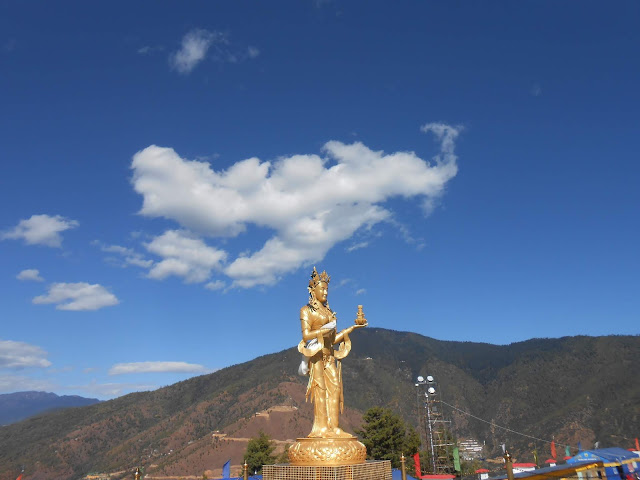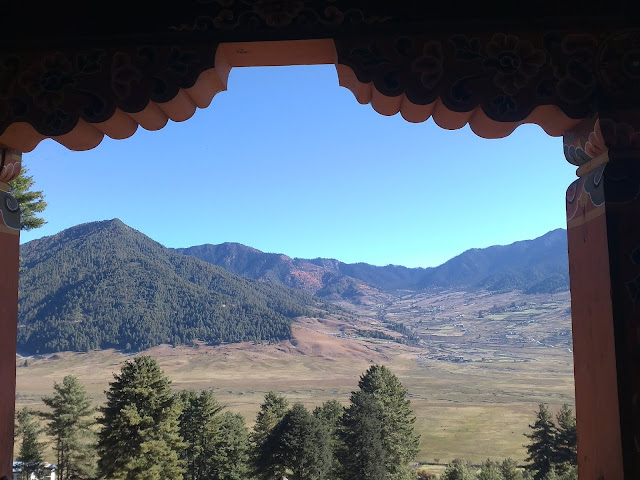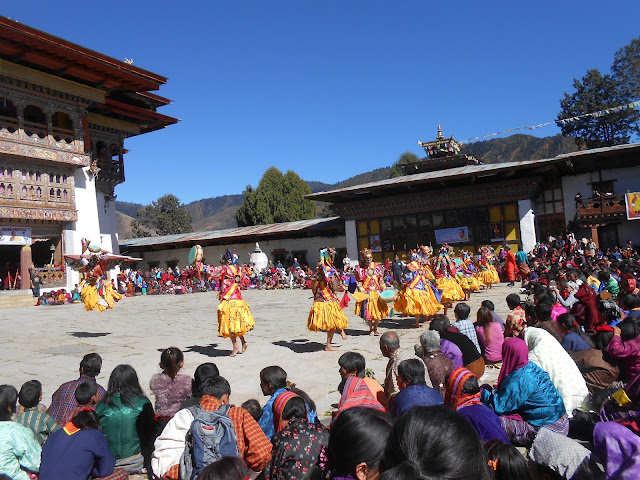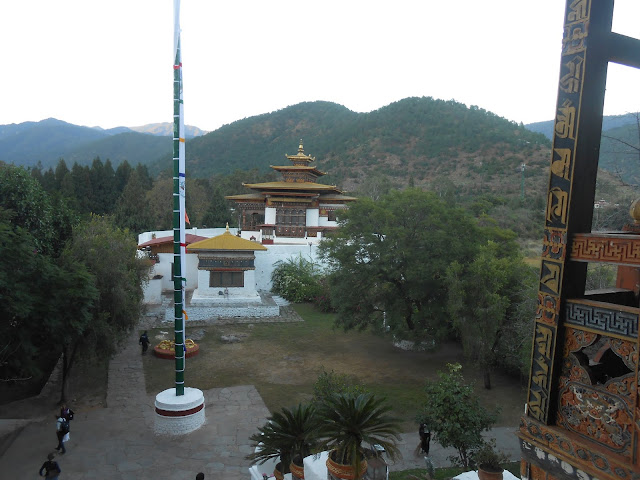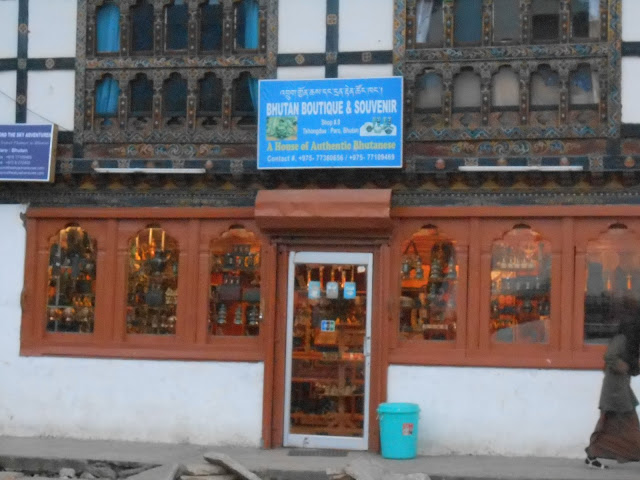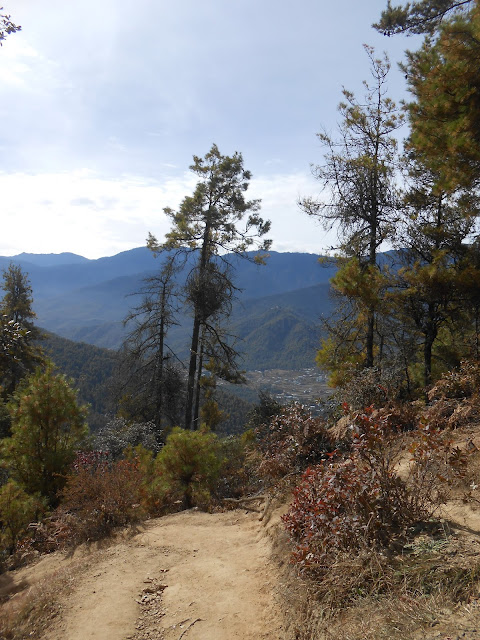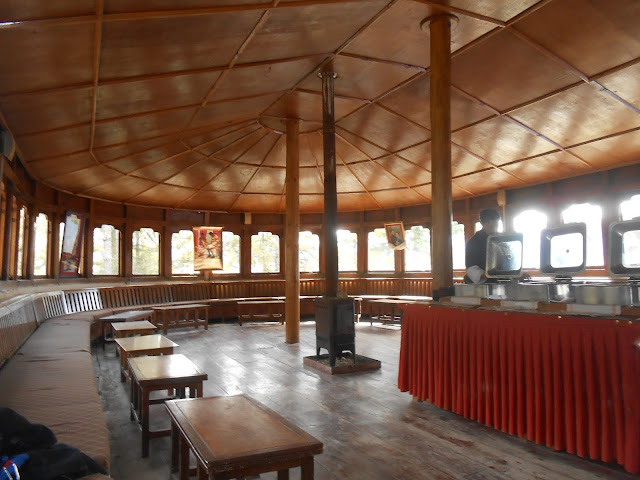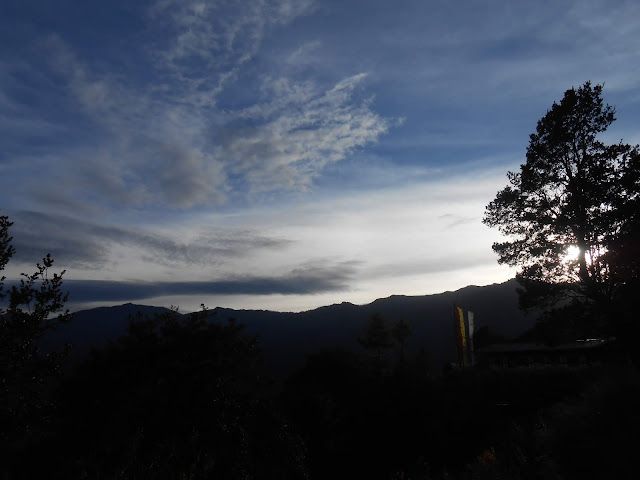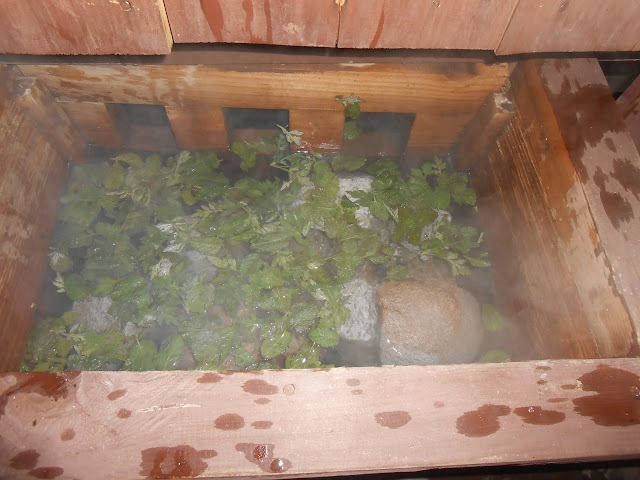TO BHUTAN– IN SEARCH OF
HAPPINESS J
The drive that would've otherwise taken 3 hours, took us 5 & our driver was happy being regaled, what with 3 wifty women, talking tripe!
Mind you, Jaigaon at the purlieus of the tea gardens looks lush & lovely, its bucolic beauty having immense potential to attract the quiet tourist.
The monks were a friendly lot & agreed to pose with us. The abbey has a separate lamasery for women monks too.
Chimi Lhakhang (The Fertility Temple)
The monastery is further afield & vehicles must be parked at a safe distance. Thus, bimbling across stretches of farms & fields, Bhutanese homes & inns, we reached its
gates. Colurful depictions of mythological creatures & images of the monastery’s 'piece de resistance' on the facades of homes did not fail to catch our attention! More on that soon..
The impressive Dzong stood unperturbed & the sparkling river flowed its course unmindful of human intrusion, if any. The few, who trod, tiptoed without much ado, but not without wearing their Apollonian smiles. The monks, who strode, flashed theirs prophetically to mean that all was well with the world. The only sounds that suffused this riverine hamlet were the susurrant sounds of the sparkling stream.
Time spent at Bhutan’s National Museum will be worth your while. Apart from tangka paintings, the museum houses a curated collection of masks, bronze statutes, costumes & jewellery.
The Natural History Section
The one on the right is our Aachu
View from the foothills
Whenever newspapers
were rife with disturbing news, each time the world was sundered by violence
& war, every time I heard or read about a suicide here or a murder there, I was provoked to ponder how things were in ‘some’ parts of the world. Those promised lands, which boasted of Elysian bliss–did their natives really lead a ‘happily ever
after’ life there? Bhutan being one of them, had always been on my bucket-list, as its famed GNH
had piqued my curiosity. And this time, it wasn’t with my family that I made
this trip; it was with 2 of my friends.
Did I
find that quiet contentment in the land just across
the border? Are our neighbors truly a happy lot? Did they manage to impart
some valuable lessons? Is Bhutan really a promising’ Shangri-La? Read on to
find out..
Black Necked Crane Festival
This trip was planned by the 3 of us, months in advance & we chose to travel in November, in time for the
Black Necked Crane Festival held in Gangtey Gompah. Although spring & summer offer
best vistas, tour agents tout that Bhutan is indeed an 'All Seasons' destination. So, ‘clear skies’, a ‘nip in the air’, fewer tourists & of course
the black cranes, wooed us to flock in early November. In the midst of this, the
Doklam issue had raised its menacing head, but ultimately, that too was quelled.
It's mandatory for tourists to travel only via travel agencies recognized by the
country & luckily, India has a host of them. Also, we were relieved that we
could plan our own itinerary.
Tea Gardens, Jaigaon
We included Paro, Phunakha, Thimphu & Gangtey in our itinerary & chose B.K. Tours & Travels, located in Jaigaon India, which readily complied with our plan. A flight to Bagdogra & a drive from Bagdogra to Jaigaon, arranged by our agent brought us to the borders. Jaigaon in West Bengal is the last Indian town, bordering the land-locked country of Bhutan.
We included Paro, Phunakha, Thimphu & Gangtey in our itinerary & chose B.K. Tours & Travels, located in Jaigaon India, which readily complied with our plan. A flight to Bagdogra & a drive from Bagdogra to Jaigaon, arranged by our agent brought us to the borders. Jaigaon in West Bengal is the last Indian town, bordering the land-locked country of Bhutan.
View of the Himalayas
Although a flight to Paro would've offered a panned view of the Himalayas, this road trip from Bagdogra to Jaigaon was equally fascinating. A quick repast later, we drove through acres of verdant tea gardens & halted by a tranquil lake overlooked by the distant Himalayan peaks! 3 friends &, on a ‘women-alone’ expedition... you can imagine & yes, our trip was laced with spells of giggles & guffaws. J
Although a flight to Paro would've offered a panned view of the Himalayas, this road trip from Bagdogra to Jaigaon was equally fascinating. A quick repast later, we drove through acres of verdant tea gardens & halted by a tranquil lake overlooked by the distant Himalayan peaks! 3 friends &, on a ‘women-alone’ expedition... you can imagine & yes, our trip was laced with spells of giggles & guffaws. J
The drive that would've otherwise taken 3 hours, took us 5 & our driver was happy being regaled, what with 3 wifty women, talking tripe!
Late in
the evening, we reached Jaigaon, met B.K. Prasad & got our currencies
exchanged. Some of the fringe benefits of being bonhomous neighbours mean that
Indians can enter with only a valid passport or Voter Identity Card (VIC). At a distance was this grand gate ornately decorated
with motifs of the dragon, beckoning us to the Land of The Thunder Dragon,
which Bhutan is also known as. The gates are open to all
&, one can cross borders & return too, although beyond Phuntsholing, a
visa is a must.
And here's when the
border differences began to emerge! Wending our way through the bazaar in Jaigaon, that
was quite dystopian in character, we entered the gates, into Bhutan & were
instantly greeted by the clear Utopian feel that sets this land apart! You
got to see it to believe. Where Jaigaon seemed homely, with littered streets, crowds
that bumped into each other, honking drivers who impatiently imprecated both cattle
& humans on their path, Phuntsholing was idyllic, with neat sloping streets,
distinct footpaths, where a few people walked briskly & fewer vehicles trundled
quietly..
Mind you, Jaigaon at the purlieus of the tea gardens looks lush & lovely, its bucolic beauty having immense potential to attract the quiet tourist.
Honking is banned in Bhutan & a lone
traffic police’s booth, stood bereft of cops. The Bhutanese as we later learnt, are sticklers for discipline & order.
Our driver informed that
the Bhutanese however, honk their horn when they enter India. When I asked if they did that to unleash their pent up frustration, he laughed &
quipped, “No madam,
The sight of this plaque,
made us feel welcome & proud too.
Karbandi Monastery
The next morning, we procured our visas & drove first to Karbandi Monastery, Phuntsholing. Alok Dey or 'Aachu', as we nicknamed him, was our driver who drove us around Bhutan. Alok being an Indian, surprised us with his unflinching loyalty towards Bhutan, during our precursory chat with him, when he had casually exclaimed, ‘Hamare Bhutan mai..’ (in our Bhutan)! His frequent usage of pleasantries when he hailed a passerby & interjected 'Aachu' to mean ‘excuse me’ or ‘hear me’, earned him this sobriquet 'Aachu'! Aachu won us over & if you happen to travel through B.K.Tours, do ask for him.
Karbandi Monastery, ensconced in
a pretty pleasance, is a pleasant one that serves as a peaceful prelude
to all things that Bhutan has to offer.
From this point, as Aachu had warned, we did experience a sharp dip in the temperature.
From this point, as Aachu had warned, we did experience a sharp dip in the temperature.
Gliding
along steep curves, mountain passes & deep gorges festooned with colorful
prayer flags, we reached this restaurant, where we pulled over for
refreshments. A tangy tamarind drink seemed refreshingly different & some
small talk with the charming owner got us on the road again.
(photo courtesy-PK)
Thimphu
Thimphu
A little after sundown, we reached the capital– Thimphu. The sights that greeted us
were strikingly different from the ones we had just then beheld.
Flanking the roads were furniture shops, cloth
shops & inns. We checked
into Hotel Amodhara, whose clean & spacious rooms matched its lovely
exteriors, which came to light the following morning.
Ace Club, Thimphu
However, before calling it a day, we ventured into the local pub–Ace Club. Surprisingly, the place had a karaoke bar & the ensuing pot-valour had me boldly crooning a popular number... An unknown land, absolute strangers, the algid weather & the company of friends induced a nonchalance with which we staggered back to Amodhara. Wasn’t that the way to enjoy a vacation with friends? ☺
However, before calling it a day, we ventured into the local pub–Ace Club. Surprisingly, the place had a karaoke bar & the ensuing pot-valour had me boldly crooning a popular number... An unknown land, absolute strangers, the algid weather & the company of friends induced a nonchalance with which we staggered back to Amodhara. Wasn’t that the way to enjoy a vacation with friends? ☺
Hotel Amodhara, opened up the following morning, as a picturesque inn, with pretty rosemaling on its window sills. This typical hill-resort with alpine blossoms dotting its precincts, lent a cheerful fillip to our day.
The roof depicting a Mandala
Post breakfast, we walked down to National
Textile Museum, Thimphu. Save an occasional vehicle, the clean roads remained clear of traffic. The buildings that dotted the landscape were few & far between
& comprised a Korean Hotel, some shops and government buildings, with all
of them bearing a striking resemblance. But for their colours & designs, buildings in Bhutan look alike.
Road intersections– interspersed with one of the
8 lucky symbols, serve to redirect traffic.
National Textile Museum, Thimphu
Barring the outliers & the thangka,
we weren’t allowed to click anything. The museum has a modest collection of
Bhutanese textile & costumes worn by its various tribes, among which were the Gho or kilted skirts worn by men & ‘kira’ worn by women. The museum also stocks handicrafts but I suggest, try the ones sold
in the ABC (Authentic Bhutanese Crafts Bazar), as they’re cheaper & you can
haggle too. More on that later.
The Buddha Dordenma
Our next stopover was this. The Great Buddha Dordenma is a constant in Thimphu. This cyclopean Shakyamuni statue, made of bronze & gilded, sits majestically, overseeing most parts of the city.
As we inched closer, the pint-sized
statue that still conspicuously jutted out of the distant mountains, began to
loom large, until it dominated the azure skies. With every turn on the
hairpin bend, different
facets of the Buddha slowly came to view, until we came face to face with the
gargantuan colossi that looked down benevolently upon sentient beings.
Enshrined within are 1,20,000 more
statues!!
Once inside the courtyard, we were wowed by more
statutes–36 in all. They stood tall & proud, elegantly looking upon all
& sundry–each one
holding one of the 8 lucky symbols, I suppose.
 |
Couldn’t resist clicking this Confucius
‘look alike’J
|
The floating clouds on the cerulean skies, the salubrious weather, the calm composure of the monks & the benign look of the smiling Buddhas-all lent an absolute serenity to the atmosphere, which was so contagious that it settled right into our souls.
As I was flashing my camera for some perfect shots, I came across this fascinating image. Even the floating clouds had taken the form of a Druk-the Thunder Dragon (Bhutan’s national emblem) that appears on Bhutan’s national flag, & the statues below, holding precious jewels to symbolize prosperity, made for a picture-perfect moment!
The meditation hall in the inner chamber is not to be missed for 'that' solace you may be hankering after. When I sat in quiet
contemplation, nothing but the alfresco images that I had just then captured, began to float before my eyes.
We still had places to go & hence reluctantly began our descent but at each step, our feet lagged, as we
paused to have a bird's eye view of the city from atop the monastery.
Prayer flags & Thanga paintings
along the route
Due to paucity of time, we chose to avoid Memorial Chorten. However, we did manage to click some pictures of the Chorten.
Memorial Chorten (Jangchup Chorten)
Aachu suggested that we visit a monastery, where the infant prince was christened. One cannot overlook the fact that the Bhutanese revere their royalty & this can be seen in the several banners that adorn prominent niches on the streets, the shops & the souvenirs that bear His Majesty’s image. So we strode into this monastery, wanting to know more about the place.
Outside, the prayer flags fluttered excitedly, as if striving to spill the beans about a well-kept secret.
Aachu suggested that we visit a monastery, where the infant prince was christened. One cannot overlook the fact that the Bhutanese revere their royalty & this can be seen in the several banners that adorn prominent niches on the streets, the shops & the souvenirs that bear His Majesty’s image. So we strode into this monastery, wanting to know more about the place.
Surprisingly,
it appeared to be nondescript but admittedly peaceful.
It was then
that Aachu informed that the handsome King Jigme Khesar Namgyel Wangchuck’s
motorcade had just whizzed past! Wasn’t that a very unobtrusive appearance for
a royalty? You’d soon learn more about the monarch's down-to-earth deportment.
One such banner of the King & what He stands for..
One such banner of the King & what He stands for..
A plateful of Puchkas later, we set off to Thimphu
Dzong. According to Aachu, Punakha & Paro Dzong would be worth our while,
so we preferred watching the ‘Flag Down Ceremony’ at Thimphu Dzong.
Thimphu Dzong
ABC Bazar (Authentic Bhutanese Craft Bazar).
That was our last day in Thimphu & we spent the evening shopping for souvenirs in the unmissable ABC Bazar (Authentic Bhutanese Craft Bazar).
The neat row of shops that lined one end of the road had many interesting titbits, ranging from fire-breathing dragons carved in wood to treen work that included bowls & ladles, handmade soaps & incense-sticks, scarves, stoles & Tangkas, singing bowls, fridge magnets bearing the 8 lucky signs & other landmarks of Bhutan but the ubiquitous among them were those of the winsome King & his graceful Queen.
This is one place where we could haggle. I cannot miss commenting on the commendable conduct of the shopkeepers. Polite & ever-smiling, they conceded wherever they could & when they couldn’t, they did that with a courteous ‘noooo’, that sounded more like a ‘please’..
SAARC Building
The subsequent morning, we tried exploring the city on our own & walked into a few curio shops.
This shop here ‘Happiness Shop’, with downed shutters, made it appear as if only ‘Open Sesame’ summons would lead to the unlocking of some magical mysteries that lay within.
We then strolled into Ambient Cafe for some homemade muffins & espresso coffee.
Thimphu Dzong
We did pass by the King’s palace &
amazingly, but for a few extra embellishments, the palace could’ve passed
off as just another residence! When my friend pointed that out, Aachu explained
that such blazonry was meant only for temples & monasteries!
ABC Bazar (Authentic Bhutanese Craft Bazar).
That was our last day in Thimphu & we spent the evening shopping for souvenirs in the unmissable ABC Bazar (Authentic Bhutanese Craft Bazar).
The neat row of shops that lined one end of the road had many interesting titbits, ranging from fire-breathing dragons carved in wood to treen work that included bowls & ladles, handmade soaps & incense-sticks, scarves, stoles & Tangkas, singing bowls, fridge magnets bearing the 8 lucky signs & other landmarks of Bhutan but the ubiquitous among them were those of the winsome King & his graceful Queen.
This is one place where we could haggle. I cannot miss commenting on the commendable conduct of the shopkeepers. Polite & ever-smiling, they conceded wherever they could & when they couldn’t, they did that with a courteous ‘noooo’, that sounded more like a ‘please’..
The subsequent morning, we tried exploring the city on our own & walked into a few curio shops.
This shop here ‘Happiness Shop’, with downed shutters, made it appear as if only ‘Open Sesame’ summons would lead to the unlocking of some magical mysteries that lay within.
We then strolled into Ambient Cafe for some homemade muffins & espresso coffee.
Ambient Cafe
A haimish atmosphere with a decent stock of interesting coffee-table books, besides the tasty eatables, makes it quite sought after.
Some pretty blossoms meant
to gladden the guests at Amodhara
Black Crane Festival, Pobjikha
Soon, bidding adieu
to Thimphu, we sped off to Pobjikha Valley for the famous Black Necked Crane Festival,
scheduled to be held at Gangtey Gompa on the 11th of November 2017.
This journey was arduous, but the picturesque Pobjikha Valley more than made
up for our efforts.
Pobjikha Valley
Pobjikha Valley
We reached Pobjikha around 8 p.m, the cumbersome excursion having lasted almost 6
hours. To worsen matters, not all parts of this remote valley enjoy the
luxury of electricity. Nevertheless, the few resorts that dot the valley do have
those privileges & luckily, ours did. We checked into Gakiling Guest
House-a humble log-house, typically found in the hills.
Lugging our luggage
through the rickety wooden staircase, we reached our room on the first floor. The spacious rooms were colourfully done. The exquisitely rosemaled walls, pillars, roofs & doors imparted a distinctive Himalayan grandeur.
(photo courtesy-PK)
We huddled together on the carpet around an electric heater, whose two out of four sides emitted heat. That was frustrating but we snuggled close to it rubbing our frozen palms, until dinner arrived. And when baked potatoes, Ema Dachi, spicy bitter gourd & rice were dispatched, we gratefully partook of all that we were proffered.
(photo courtesy-PK)
We huddled together on the carpet around an electric heater, whose two out of four sides emitted heat. That was frustrating but we snuggled close to it rubbing our frozen palms, until dinner arrived. And when baked potatoes, Ema Dachi, spicy bitter gourd & rice were dispatched, we gratefully partook of all that we were proffered.
The food was cooked
differently but was undeniably palatable & for breakfast we had butter tea or
Suja as its known as in Bhutan. The locals recommend Suja for the
warmth it provides. Very soon, Suja for its salty taste & buttery feel, became my favourite.
The morning after, when we emerged out of our room, lo &
behold, the ebony drop scenes of the night had been lifted & in their place
was this divine dell cloaked in breathtaking hues!
The vale lay bathed in a warm glow of sunshine that threw light on its true colours!
The
distant blue mountains formed the backdrop for those veiled in verdure & a
row of Pine trees stood as if awaiting a grand spectacle.
The owner's mother at her loom
A room with a View!
Having a steaming cup warm my hands while basking in the warmth of the early morning sun, on a cold winter day & gazing at the seamless visual spread that lay before me, was certainly the high point & I wished I could freeze the moment!
Having a steaming cup warm my hands while basking in the warmth of the early morning sun, on a cold winter day & gazing at the seamless visual spread that lay before me, was certainly the high point & I wished I could freeze the moment!
We had to
tear ourselves away, as the festival had already begun. So, we hastened to Gangtey Gompa (Monastery), located
in Pobjikha Valley in Wangdue Phodrang district. This 17th
century monastery rose to prominence due to the annual Black Necked Crane Festival
held here on the 11th of November every year.
The Black
Necked Cranes, locally called Thrung Thrung–an endangered species make an autumnal appearance every October,
when they fly down to Pobjikha Valley from the Tibetan plateau & roost here
till spring, after which they spring back. Interestingly, the birds upon
their arrival in October as well as before their departure in February are
known to circle the Gompa thrice! To the Bhutanese, these are sacred birds, reincarnated
as the two deities believed to protect the valley & their three-fold
circling of the Gompha denotes the protecting of the Three Jewels of
Buddhism-the Buddha, the Dharma & the Sangha.
The
environmentalist deemed the conservation of this species as imperative. The
culturist, recognizing the exigency to spread awareness, tapped the existing
theism & thus the birth of the Black Necked Crane Festival in the year
1998.
One thing caught my attention. A group of young women had already begun
to perform, when all of a sudden the sound-system got impaired. However, they continued with their dance–without a dither; without a demur & not a single woman winced. In fact, they smiled
graciously & chorused along till the sound system sprang back to life! I
couldn’t help comparing notes & imagined the look of chagrin performers elsewhere would’ve displayed.
There were families that
had brought their tots & together they cheered the performers, ate, &
made merry. When they left, they took the leftovers with them. Not that the
place was litter-free; no, in some places, I did notice some mess. But, noteworthy was their respect for their culture; no one jeered, hooted, distracted or ogled the performers.
We broke for lunch,
after which we ambled along, capturing the splendour of the virgin valley.
(photo courtesy-PK)
This is my baby..
Long
ago, I had read somewhere about the Bhutanese belief that till the age of 2, an infant’s feet aren’t
supposed to touch the ground & hence it’s a common sight to find mothers
carrying their babies fastened to their backs.
That evening, we
visited the 'Black Necked Crane Information Centre' for audio-visual
information on the birds.
A viewing room with a number of telescopes strategically placed, offers precise views of the birds at the faraway valley. Visitors can don the costume of this Crane & pose for photographs.
Pobjikha Valley with its pastoral charm had held us spellbound & we decided that it does merit a
revisit.
(photo courtesy-PK)
Punakha
We reached Punakha the next afternoon & checked into Punakha Residency- a family run hotel, managed by a very cordial couple.
Punakha Resdidency
The glorious Dzong, right
at the foothills of a curvaceous mountain, lies at the confluence of the
Po Chu (father) River & Mo Chu (mother) River. This spectacular monastery
is undoubtedly any photographer’s fascination, a poet’s muse, and the seeker’s
paradise.
However, we heard that it is in spring that the beauty
of the monastery is accentuated, when the snow-white edifice is embosked in lilac Jacaranda blooms.
A permit to the monastery can be made after reaching the site; Aachu got ours done. A young monk took us around & gave us details of the history of the monastery.
A permit to the monastery can be made after reaching the site; Aachu got ours done. A young monk took us around & gave us details of the history of the monastery.
A bridge links the road to the monastery & some of the finest snapshots that can
be had, are from this bridge.
The entrance has a steep flight of steps that opens into a vast courtyard, which presents a sweeping view of the monastery
in all its stateliness.
The wooden windows embellished with motifs of
Bhutanese mythological characters, & set against the white facade, make this monastery aesthetically outstanding.
A guard who agreed to pose for me
A guard who agreed to pose for me
At the farther end, is the Hundred Pillar temple, housing mammoth
golden statues of the Buddha, Guru Rinpoche & the Divine Madman; the third
is something I shall touch upon soon.
The monks were a friendly lot & agreed to pose with us. The abbey has a separate lamasery for women monks too.
Punkha Suspension Bridge
After an hour’s ramble through the monastery, we were game for an adventure. The Suspension Bridge, is another touristy place. A scramble along an uneven path & a hop skip & jump across wooden stiles brought us to the foot of this bridge. The stiles, we heard were boundaries set up for farmers.
Strung across the Po
Chu River, the bridge spans 160m to 180m & is a wobbly one although made of
metal.
As soon as we set foot on the
bridge, it began to rock! Below us, were the raging rapids & midway as we peeped, the river had gathered force! Initially,
we had thrown cautions to the wind as we were eager to explore but after having
reached midway, when there was no going back, we teetered along balancing our
cameras & haversack. We were literally caught battling our own devils in
the midst of the deep blue river!
At the
other end stood a humble yet beatific monastery, which was closed for the day.
Chimi Lhakhang (The Fertility Temple)
The ensuing morning saw us heading off to Chhimi Lhakhang. Remember the Divine Madman statute at Punakha Dzong? Chimi Lhakhang is dedicated to Drukpa Kungley-a monk cum poet branded as a 'madman'.
A granary
This brief stretch made me wonder if we had made a mistake of having planned this trip in fall. I’m
sure in spring & summer this place would be veritably verdant.
Not only in India,
but even in Bhutan the Linga is worshipped, in fact quite boldly & Chimi
Lhakhang’s object of worship is the Phallus! When we bowed our heads, we were taken aback to find a pair of phalluses being placed on our head by the monks! That's the custom! Little wonder then, that these form the leitmotif on all homes along the way. ☺
The Gates Leading to Chimi Lhakhang
The Prayer Wheel at the Entrance
The Gates Leading to Chimi Lhakhang
The Prayer Wheel at the Entrance
On this note, Chimi
Lhakhng attracts childless couples too, who visit the place to obtain
blessings.
That chilly afternoon when the sun shone overhead, each of us assumed position
under a tree & tried soaking in the ambience of this Last Paradise on Earth. I guess, each had realized the importance of solitude & each gave the other that space.
The fragrance of the green turf, the flutter of prayer flags, the distant drone of incantations by an old woman while she turned the prayer wheels & the furtive exit & entry of the monks on their mission, invoked a sense of tranquility & heartsease.
Perhaps, the monks had perceived this & hence the ban on vehicles in the vicinity of the monastery.
The fragrance of the green turf, the flutter of prayer flags, the distant drone of incantations by an old woman while she turned the prayer wheels & the furtive exit & entry of the monks on their mission, invoked a sense of tranquility & heartsease.
Perhaps, the monks had perceived this & hence the ban on vehicles in the vicinity of the monastery.
In an hour, we collected ourselves & resumed our journey.
Couldn't help clicking this. Plastic is banned in
Bhutan & do you know how they make use of plastic bottles? They're painted in bright colours & scrawled with ‘Om Mani Padme Hum’ & then pierced on spikes. When the blustering wind turns the bottles around, the prayer
wheels with inscriptions are for all to see! How innovative that!
En route, you'd see several shops
selling curious & keepsakes, among which the phalluses are the cynosure!
Note: Some stuff,
like cream based perfumes that are sold in Punakha, according to me, aren’t
available elsewhere in Bhutan.
We spent the evening
chatting with the locals, who enlightened us on Bhutanese culture & ethos
& about the royal family, which they literally idolize.
The last on our
itinerary was Paro. Early next morning, we proceeded to Paro & en voyage halted at the iconic Dochula Pass. The place comprising 108 Chortens built on a hillock, presents a 360
degree panoramic view of the Himalayan ranges.
Dochula Pass
Like crown jewels, the chortens rise & shine forth to espy the dale below and the snow-rimmed Himalayas yonder. And the woody tor that forms a coulisse– like a guardian angel, embosoms the stunning scene below.
Dochula Pass
Like crown jewels, the chortens rise & shine forth to espy the dale below and the snow-rimmed Himalayas yonder. And the woody tor that forms a coulisse– like a guardian angel, embosoms the stunning scene below.
A view from the eatery
Late evening, we reached
Paro & checked into one of Pelri Cottage’s cozy rooms. Pelri Cottage as the
name goes, has several cottages dotting a slope, whose vividly done
up dining hall is an eye-catching zone.
Rinpung Dzong, Paro
Rinpung Dzong or the
Paro Dzong is the administrative building for government officials &
monastic body. So, we did not venture into it. However, the dzong along with
its quaint bridge is a photographer’s delight!
The impressive Dzong stood unperturbed & the sparkling river flowed its course unmindful of human intrusion, if any. The few, who trod, tiptoed without much ado, but not without wearing their Apollonian smiles. The monks, who strode, flashed theirs prophetically to mean that all was well with the world. The only sounds that suffused this riverine hamlet were the susurrant sounds of the sparkling stream.
(photo courtesy-PK)
We wandered for a while trying to behold & descry as much as we could. Imbibing all that, we moved on to our next port of call.
National Museum, BhutanWe wandered for a while trying to behold & descry as much as we could. Imbibing all that, we moved on to our next port of call.
Time spent at Bhutan’s National Museum will be worth your while. Apart from tangka paintings, the museum houses a curated collection of masks, bronze statutes, costumes & jewellery.
Of particular interest to me were the intriguing masks on display. Most masks were those portraying animals. According to some beliefs, the face at the time of death indicates the wishes, dreams, yearnings, qualms & fears one nursed while one lived! Do not miss the audio-visual programme exhibiting folk dances & practices of the locals.
The Natural History Section
The vast display of faunal
& avian diversity on screen is also not to be missed. Specimen of the Takin (Bhutan’s
national animal), snow-leopards, deer & birds are the other exhibits
here. It took us about 2 & half hours or more, to take a proper dekko.
The portico offers a
vantage view of the silent valley & a few quiet moments here, can be
undeniably energizing.
I usually never leave
a place without trying its traditional costumes & as
luck would have it, Aacho informed that by the Paro Chu (Paro River), there
indeed was a place where tourists could get photographed in traditional habits. I, escorted by Aacho, rushed to this
place. There, by the gushing river, a few people had already gathered. A
senior Bengali woman was ready in her raiment. Inside a log-hut were a dozen traditional liveries hung in neat rows. I selected
one & got myself clicked.
We spent the evening at Paro’s colourful & exotic market place, collecting curios & souvenirs.
We had an early night, for, the world-renowned Tiger’s Nest was on the next day's agenda.
We had an early night, for, the world-renowned Tiger’s Nest was on the next day's agenda.
Tiger’s Nest or
Takstsang is Bhutan’s Jewel in the Crown! Think Bhutan & it is this picture
that will naturally be evoked. Bhutan is synonymous with Tiger’s Nest & any
trip to Bhutan is incomplete without a visit to this monastery that's perilously perched over a precipice! Our real adventure began here!
We commenced our trek at 9 a.m. sharp. Ponies are available
till the cafeteria but we chose to trudge. We befriended some Indians, who proposed to journey with us. Given our pace, some gave
up hanging around.
The path uphill
View from the foothills
It was then that we
met a group of young boys, which stayed with us till the end. The crowd that
was herding ahead was already thinning out & in fact, the number of people
descending too had begun to trickle.
Those heading downhill gloated about what they saw up there. The nearer we went, the farther our destination appeared. We lumbered laboriously & around 1.30 p.m, we still had the last 700 steps to cover. We clambered inchmeal & reached the gates of the Tiger’s Nest at 2.30 p.m.
The Cafeteria
The sentries at the
gate offered us a cup of coffee & confiscated our cameras & cells.L The dank
sanctums were divinely soothing. Monks in burgundy robes, sat
still–their noetic face reflecting a
mysterious revelation. A little boy, who was also a monk, was busy fetching
water. To think that this little boy, barely seven, was away from his
family, in the midst of strangers, was unfathomable! A few familiar faces, upon sighting us, looked surprised. They were ready to descend. The 2 of us, Sarith
& Jerry (the 2 young men), along with a handful of pilgrims were the only
ones left. One of our own friends was at the cafeteria awaiting our arrival.
The Tiger’s Lair
Our visit was still incomplete, we were told. We
were then led to a cave where a lamp was kept lit. To have a glimpse at that, we had to slide down a ladder that was placed aslant two walls of the cave! Few pilgrims had begun to
crawl down & my friends too were game for it. I resisted, as I was
exhausted. Those who went in, came back quite enthralled.
When the last bunch
of visitors began to leave, we knew we had to hurry. Turning back one last time, we began stepping down. By then, the
mountain, which was swarming with tourists, wore a deserted look. My friend too darted down, as we had another waiting at the cafeteria. I had Sarith for company but the one at the cafe, had none. Jerry accompanied my
friend. Despite our trepidation, we still managed a few snapshots; some places
in the world are to be cherished.
By 4 p.m. the sun too
had begun its descent & that’s when Sarith & I began to panic. We had
left the monastery far behind & we had miles to go before we reached the
town; there was not a single soul in sight!
We called out to our friends but
only the mountains echoed. Imagine our plight in the desolate mountain fastness, with no
clear paths, no lights to reveal our next step & with the sun already at
the horizon! Remember it was winter & we were towards the East. To make
matters worse, some parts of the mountains were covered with sandy soil;
clueless how. Our cells had no connectivity.
First time in my life, I realized the Sun’s significance. I’ve always loathed summer but that evening in that forlorn mountain, I promised myself, the Earth & the Sun, that the coming summer would see me turning into a new leaf; that there’d be fewer expletives spewing forth my mouth. School geography had no place for misplaced anger☺ 

I pleaded with the Sun to linger longer. I implored the Earth to slow down..How silly, but as an answer to my orison, from nowhere, appeared a mountain mongrel!
Was it a wolf, was it a dog, was it a werewolf, I’ll never know, but it came sprinting towards us & stopping at a distance, peered at us. Was it going
to pounce? On one hand was the hound & on the other, the deep gorge! That
morning Aachu had warned us about Jungli Billis (snow leopards), on the prowl.
We made haste but the dog followed us, still keeping a decent distance.
Upon hitting the water
faucet area, where we had paused to refresh that afternoon, Sarith
suggested that we take a shortcut but I was firm about following the
familiar trail. The dog was still close on heels but his presence by then was apparently comforting; at least there was another soul & that too, a harmless
one. I knew I’d live to tell this tale but the thought of languishing atop the
hills till day-break, was indeed frightening. Tourists would start trooping
in only at dawn, which was a good 12 hours from then.
One wrong & hasty
step & we’d go hurtling down. The slippery path apart, tree-roots had clawed
their way deep into the pathways & had resurfaced at some points. The
sun had set & the afterglow was all that we had, so we plodded on. Calling out
our friend’s name was to no avail & suddenly we wondered if they were safe.
The dog too had disappeared or so we thought, when suddenly after a few
minutes, he reappeared & resumed trailing.
The temperature was
dipping steadily. In sometime, we met a handful of natives who asked if Jerry
was our friend. We were stunned. Sensing our
apprehension they assured, “Don’t worry. Jerry had lost his way but some
villagers found him & are escorting him”. We heaved a sigh of relief. The town, they said was only 30 minutes away & we were on the
right track. What about my friends? They were clueless.
By now, the afterglow too had dimmed & all we had were the flashlights of
our mobile phones. When we paused, the dog too stopped. When we resumed, the
dog faithfully followed us. Not once did he bark, not once did he growl. Was he
a godsend?
With time, the
landmarks that we had crossed in the morning came into view. Our joy knew no
bounds. In no time, we could hear the sound of vehicles & we cheered up. Soon, we saw someone flashing a torchlight & heard a
familiar voice call out to me. That was Achu’s! We were overcome by relief. And
my friends? They were safe in the car, he said. One had been waiting since 2
hours & the other accompanied by Jerry had just arrived! Thank heavens! I
raced ahead, of course bidding Sarith farewell. And my dog, nay wolf? The moment he saw that we had reached our 'port in the storm', he stopped midway. He looked at me with tender eyes, as if to say that this was our last
time. He remained in the background, concealed by the trees & shrubs &
before I could reach for my camera, he wagged his tail & began to beat
a retreat. A mute creature had kept us company. I
bade him Godspeed & proceeded to meet my waiting friends. Even to this day, I think of this kind creature & pray for his safety. He was surely a godsend.
Tips before you trek
to the Tiger’s Nest
Start at dawn. Our '9 a.m. commencement' was too late.
Have a light
breakfast & carry one water bottle, as en route, you will get
water. Wear comfortable shoes.
Travel light. Unless
you're an ace photographer, your cell’s camera will do but ensure that it’s
fully charged.
No matter how cold it
may be, one sweater will do. Leave the rest in your vehicle.
If part of a group,
then divide your paraphernalia & avoid rushing headlong.
Cane sticks are available for a paltry sum & when you return yours, you’ll get a half
refund. Use them to negotiate your way. Ponies ply only up till the cafeteria.
If you aren’t
comfortable but are compelled to go, then it’s wise not to venture.
It’s true, Tiger’s Nest is Bhutan’s icing on the cake but if your health does
not permit, better be kind to yourself. We did hear of a tourist who
had lost his life while hiking.
It should ideally not
take more than 6 hours to hike up & race back, with an hour’s bio-break
thrown in between. However, to be still on top at 3 pm, is clearly asking for
trouble.
Hot Stone Therapy
As planned, we were
taken to the Hot Stone Centre for treatment. We were fatigued & desperately
needed some warmth. This may not be your
traditional hot stone massage but is effective enough to relieve all aches
& pains.
Large pebbles heated on a bonfire are slowly transferred into the water
through the outlet on the stone tub. The hot pebbles warm up the water that is
infused with mint & other Himalayan herbs. Soaking in this warm aromatic
water is what the Bhutanese call hot stone therapy! It was no doubt refreshing
& after an hour, we were raring to go.
Early morning, we
left Paro for Phuntsholing. We had to head back home L. As Achu had
promised, he took us to the riverfront where an old woman sold mementoes at a cheaper rate.
Paro Chu
Clement climes & the pellucid waters of the Paro Chu─ rimmed with towering Pines, sent my spirits soaring that day. Hills have it in
them to liberate, to set man free & instill unbounded joy.
(photo courtesy-PK)
The load on our lens loosened our purse strings, as we bought chilies & cheese along the way.
The load on our lens loosened our purse strings, as we bought chilies & cheese along the way.
Red chilies often
left to dry on rooftops, are a usual scene. These are known for their characteristic flavor, we were told.
Yak Cheese
The road leading to Doklam Pass
Cherry blossoms
The average man too is duty-bound. I was a sight when my friends made me hold their shawls & sweaters and decked my
head with 3 hats! While I thought that the guy staring at me was going to laugh, I
was surprised when he nervously pointed at the zebra crossing.L
The road leading to Doklam Pass
The border town of Phuntsholing pulsated with a life of its own. We
scoured for some more collectibles in its many shops & returned
to the hotel to pack our bags.
Many opine that it's in Paro where one finds goods at a cheaper price. However, if spending time in Phuntsholing, do walk around the market place. That way you can compare the price & if returning to Phuntsholing, you can still make those purchases you couldn't in other places. Also, this allows you to travel light to other destinations.
Dawn dawned & the
crispness in the air was distinctly invigorating. We bade goodbye to Aachu & to
Bhutan, crossed the gates, entered India & all of us turned back one last
time–wistfully. Our journey in this fairy-tale land, which had been our home for 11
days, suddenly seemed like a mere blip, a dream! Yet, the atmospheric feel was infectiously delectable & on that note, we moved on.
As we passed by the tea-gardens,
I knew Jaigaon deserves a visit sometime in future.
Back home, my family
was curious about the ‘happiness quotient’ & GNH part. Are our neighbours truly a happy lot?
No, I didn’t really
see what I expected to see –the carefree faces of happy-go-lucky folks. Unlike what I thought, even adults
never laughed or even simpered. But, definitely their seraphic smiles & equanimous poise were unmistakable.
When they walked,
they walked with a sense of purpose. Yet, their muted conduct
& sotto voce, spoke volumes of their cultural memes.
Walking on the roads was a breeze. A traffic cop can rarely be seen & I’m sure his is a cushy job! Yet,
when we tried crossing the road, where we thought we could, his pointing
out at the zebra crossing made us recall our school 'community living' lessons.
90% of the Bhutanese
are seen in their traditional attire, which again bespeaks their respect &
fondness for their culture.
Their tolerance is yet something that’s laudable. A little after Doklam Pass, a traffic turmoil had confused 2 drivers ahead of us. Each signalled to the other politely & each seemed to have understood the other’s predicament & both waited patiently for the confusion to ease out. No drama, no cuss words. Perhaps such civility may be improbable in larger nations. Yet, traversing even busy roads without fear, can be so liberating.
Their tolerance is yet something that’s laudable. A little after Doklam Pass, a traffic turmoil had confused 2 drivers ahead of us. Each signalled to the other politely & each seemed to have understood the other’s predicament & both waited patiently for the confusion to ease out. No drama, no cuss words. Perhaps such civility may be improbable in larger nations. Yet, traversing even busy roads without fear, can be so liberating.
Many times as I crossed borders, I instinctively reached out for my stole. It was then that I was reminded of Poet Rabindranath Tagore's famous poem:
"Where the mind is without fear and
the head is held high
Where knowledge is free
Where the world has not been broken up into fragments
By narrow domestic walls
Where words come out from the depth of truth
Where tireless striving stretches its arms towards perfection
Where the clear stream of reason has not lost its way
Into the dreary desert sand of dead habit
Where the mind is led forward by thee
Into ever-widening thought and action
Where knowledge is free
Where the world has not been broken up into fragments
By narrow domestic walls
Where words come out from the depth of truth
Where tireless striving stretches its arms towards perfection
Where the clear stream of reason has not lost its way
Into the dreary desert sand of dead habit
Where the mind is led forward by thee
Into ever-widening thought and action
Into that heaven of freedom, my
Father, let my country awake."
‘What is the role of
the royal family then, in this law-abiding, crime-free nation, whose political system is also incorruptible’, I asked some locals.
‘Of course we have our share of problems’, one said. ‘Drug abuse among the youth is one of them & is rampant at the borders due to drug trafficking. The appearance of television in 1999 & the introduction of mobile phones had opened a can of worms. However, the Queen Mother & her 3 sisters (her husband-Jigme Singye Wangchuk's other wives) have dedicated their life in addressing health concerns; youth challenges & numerous other issues that threaten to abrade the fine fabric that makes up this blissful Himalayan Kingdom .
The senior king had long ago abdicated his throne & his son –the young king visits one village every week to familiarize himself with his subjects & their concerns & thus, quotidian needs are taken care of. No wonder the royal family is so fondly deified.
It’s easy to run a
small nation such as this, but the existence of a land with
fewer tribulations, uncomplicated & non-materialistic people, seems so mythical in a war-torn world.
‘Of course we have our share of problems’, one said. ‘Drug abuse among the youth is one of them & is rampant at the borders due to drug trafficking. The appearance of television in 1999 & the introduction of mobile phones had opened a can of worms. However, the Queen Mother & her 3 sisters (her husband-Jigme Singye Wangchuk's other wives) have dedicated their life in addressing health concerns; youth challenges & numerous other issues that threaten to abrade the fine fabric that makes up this blissful Himalayan Kingdom .
The senior king had long ago abdicated his throne & his son –the young king visits one village every week to familiarize himself with his subjects & their concerns & thus, quotidian needs are taken care of. No wonder the royal family is so fondly deified.
Nonetheless, their reaction to others’ foibles did shock us. A press-reporter's driver was livid when our car had blocked his path at a parking space. Aachu had gone for the permit. The driver's scathing remark on Indian drivers, was certainly a put-off, this despite most of them referring to India as ‘Big Brother’ & acknowledging Indian contribution towards their economy.
Yet,
if you observe closely, there’s no cloying complaisance here. This is
something, which even the uppity to whom the colour of skin creates a certain awe,
must note.
Photo Courtesy PK
Perhaps,
their allegiance to monarchy, which in turn swears fealty to its citizens, is
what makes this country so paradisiacal.
Sonam Trophel Inn, Paro, where we lunched often
As I mulled over for
answers, I realized that this Elysian contentment that the world calls GNH,
rested on the strong pillars of pride, self-discipline, self-respect, deference
for fellow-beings & mindful living that goes to encompass Mother Nature
& her bounties.
This blithesome
Himalayan Kingdom is so out of the world, that I pray that it continues to
remain a brilliant beacon for the ‘benighted’ beings of the world...
PS: Some of the snaps have been clicked by my friends & ‘Photo Courtesy PK’ are
snaps shot by one of them, whose play with 'light & shadow’, I felt, deserved to be highlighted.
Dedicated to my friends who made this trip a truly memorable one.J














































